Your cart is currently empty!
I’ve failed in 7 niches in online business, due to I selected many mult-niche categories for the business. Then I researched niches in the online business, found my niche and started my journey on it, Then I became successful in this single niche. Today, in this article, I’m sharing my overall experiences on how I research, how I find, and what strategy I used. If you are failing and failing in your business so I think this article is for you.
What is a Niche in Business?
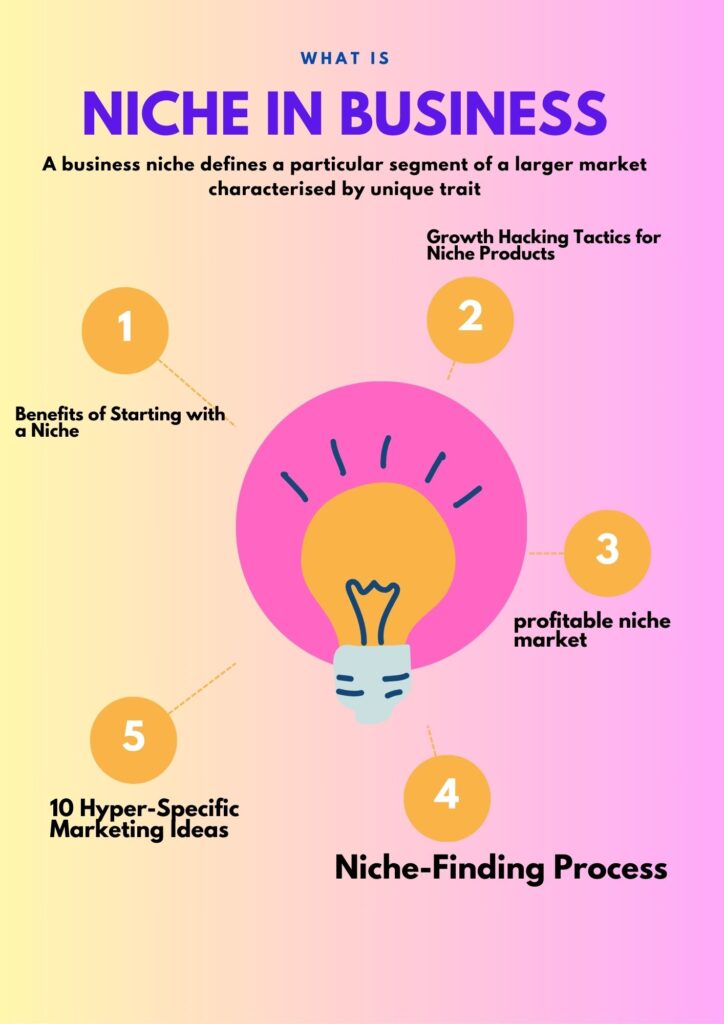
Niche products are specialised products/goods/services developed to target a specific, narrowly defined market segment which is underserved by the mainstream market. Such products are gluten-free for people suffering from celiac disease or eco-friendly phone cases for those concerned with sustainability.
Niche in Business
A business niche defines a particular segment of a larger market characterised by unique traits, needs, or identities which a general competitor does not cater to. Businesses operating in a niche concentrate on offering highly specialised solutions, which helps them stand out, reduce competition, and build customer loyalty. For instance, Drybar is a salon specialising in blowouts only, and Georgetown Cupcake only sells cupcakes. Both serve a focused customer demographic.
Niche marketing or concentrated marketing is a less popular term used in reference to niche marketing. The latter is a focused strategy that alters marketing techniques and offerings to a specified, smaller target market instead of the mass market. It aims for domination through personalised or tailored messages and expertise in a specific area, like vegan beauty products or fitness for remote employees.
Contemporary Data-Driven Examples
- Women’s clothing has a relatively low supply in the vegan segment due to ethical and lifestyle considerations, but demand is likely to increase as more consumers seek cruelty-free products.
- Biodegradable cleaning products and eco-friendly kitchenware appeal to the 64% of consumers interested in sustainability, making it one of the most important factors in their purchases.
- Remote work and home exercising have seen an increase in popularity, which is why Peloton focuses on home fitness communities as part of their target demographic.
- Etsy provides a marketplace for handmade and vintage goods, enabling artisans to sell their unique creations and consumers seeking one-of-a-kind items to purchase what they want.
- The highlighted examples illustrate how businesses successfully target niche markets, resulting in increased brand loyalty and profit margins in comparison to generalised competitors.
Does Every Business Need to Start with a Niche?
No, every business doesn’t need to start with a niche, but it can help smaller or newer companies greatly. Selecting a niche helps businesses understand how to specialise, differentiate competitively, and meet targeted customers’ needs. They can achieve high profit margins, become less competitive or market leaders in their focus segments.
Benefits of Starting with a Niche

Specialisation and Differentiation: Businesses can now tailor products and services to capture specific customer needs, thereby differentiating themselves from broader competitors. For instance, an outdoor gear store could specialise in creating sustainable, eco-friendly outdoor products and target socially conscious consumers.
Fewer Competitors: Niche segments are sparsely populated, and so companies will have to deal with little competition, thus earning with better chances of loyalty and recognition from customers.
Expert Status: Companies can promote themselves as a market authority and gain the trust of the customer, thus earning trust in the process.
Stronger Customer Relationships: Businesses can reinforce connections to serve their customers to overcome the “them vs us” scenario, focusing on individual customers.
Cons of Defining a Niche
Vulnerability to Market Changes: If there is a change in trends or a shift in what the customers want, a highly specialised business will most likely face challenges when trying to scale up or adapt.
Risk of Relying on A Single Product or Service Too Much: Some companies get overly concentrated on one focus and stop innovating or diversifying completely, which could take them off the radar if the focus niche is no longer relevant.
Visual Summary
| Benefit/Drawback | % of Businesses Reporting |
| Specialization & Differentiation | 75% |
| Fewer Competitors | 65% |
| Higher Profit Margins | 60% |
| Expert Status | 55% |
| Stronger Customer Relationships | 50% |
| Limited Market Size | 70% |
| Vulnerability to Market Shifts | 60% |
| Over-Specialization | 55% |
| Niche Saturation | 50% |
[Bar charts showing benefits and drawbacks of niche businesses, with percentages of businesses reporting each.
Examples: Niche Brands That Succeeded or Failed
| Brand | Start Niche | Outcome | Revenue/Loss (Billion USD) | Notes |
| Amazon | Online books | Success | 600 | Expanded to global e-commerce leader |
| Nike | Running shoes | Success | 450 | Grew into a leading sportswear brand |
| Tesla | Electric sports cars | Success | 300 | Now dominates EV and energy markets |
| Drybar | Hair blowouts | Success | 100 | Expanded into hair products and tools |
| Chewy | Pet supplies | Success | 110 | Became a top online pet retailer |
| Bonobos | Men’s pants | Success | 90 | Expanded into broader men’s fashion |
| Tie Rack | Ties & scarves | Failure | 0.1 (loss) | Overly narrow focus, didn’t adapt to shopping behaviors |
| Pets.com | Online pet supplies | Failure | 0.3 (loss) | Poor timing, unsustainable model |
| Cheetos Lip Balm | Snack-flavoured lip balm | Failure | 0.05 (loss) | The niche was too odd, no demand |
| BrewDog Screeching Beers | Extremely high-alcohol beers | Failure | 0.02 (loss) | Alienated core customers, poor fit |
| JCPenney | Department store niche | Failure | 1.0 (loss) | Couldn’t adapt as market shifted |
| RadioShack | Electronics retail | Failure | 0.5 (loss) | Failed to innovate, lost relevance |
Key Points
- Over 80% of new fashion brands go under within five years, many struggling with poor market fit and failure to adapt.
- Targeting niches can drive strong early growth, high brand loyalty, profits, and margins, but only if the niche is large and stable enough to sustain the business in the long term.
- Some of the world’s biggest brands started with a niche and scaled — Amazon (books), Nike (running shoes), Tesla (luxury EVS), and even Chewy (pet supplies) initially had a focused offering before expanding.
- On the other hand, Tie Rack and Pets.com are examples of brands that failed because their niche had not flexible boundaries, was too small, and did not align with the ever-changing needs of consumers.
Not every business has to start with a niche, but if a niche is selected wisely, it offers flexibility and provides great growth potential, then the business becomes more adaptable. The most successful brands are those that use their niche as a launchpad, while those that fail often cling too tightly to oversaturated segments.
10 Examples of Niche Markets with Ideas and Strategies for Definition
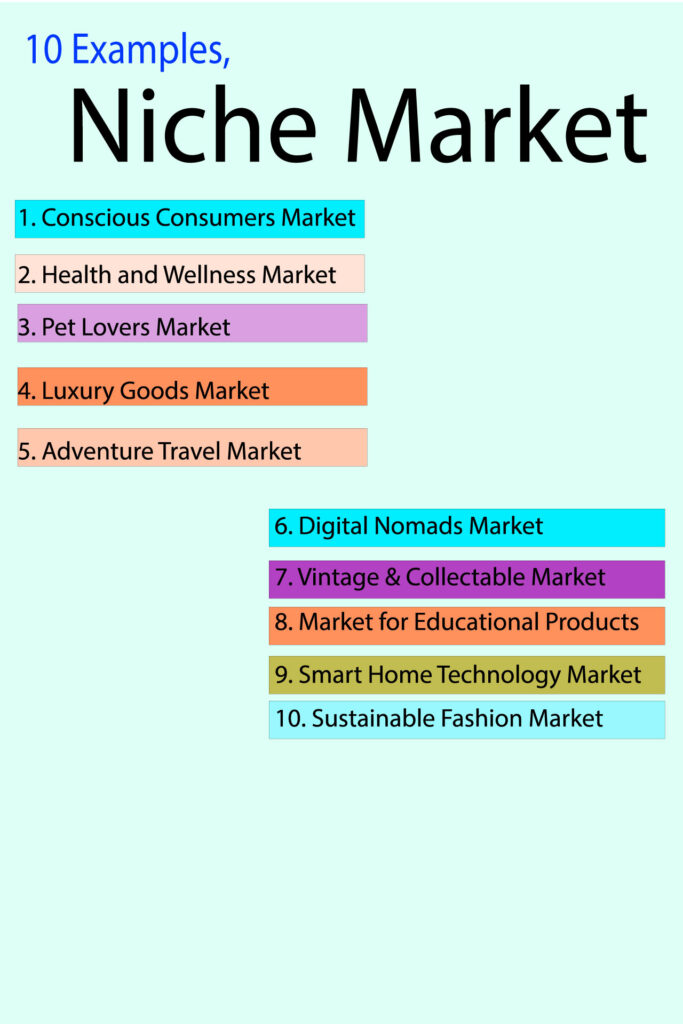
A niche market is a specialised, identifiable subset of a larger market that, due to particular demographics, psychographics, or unique need, is overlooked by the larger market. Below, we’ll list 10 of the most popular niche markets, their characteristics, and some examples of niche products or services. You will find a description of how a market can be broad versus niche, how to determine sub-niches, and available contemporary data/statistics, if relevant.
1. Conscious Consumers Market
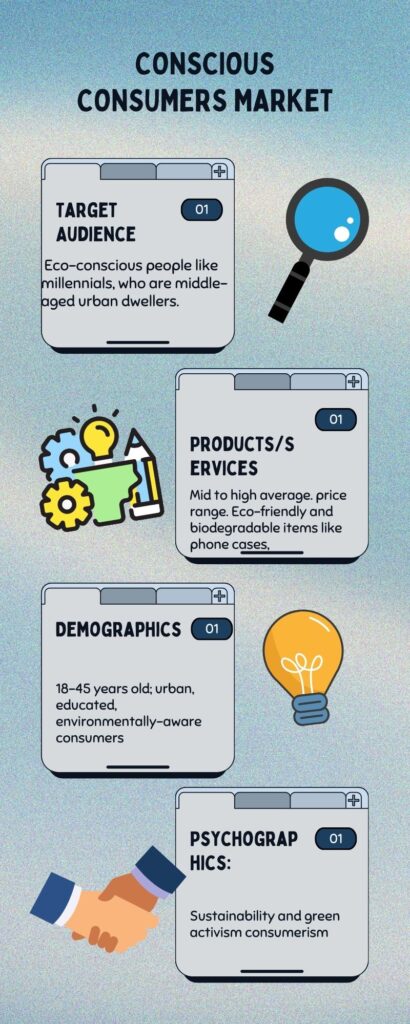
Characteristics:
- Target Audience: Eco-conscious people like millennials, who are middle-aged urban dwellers.
- Products/Services: Mid to high average. price range. Eco-friendly and biodegradable items like phone cases, organic beauty products, and reusable shopping bags.
- Demographics: 18-45 years old; urban, educated, environmentally-aware consumers
- Psychographics: Sustainability and green activism consumerism.
- Geographics: Global scope, urban centres, big demand in developed markets.
- Industry Focus: Retail, fast consumer goods (FMCG).
- Customer Loyalty: High due to shared environmental values.
Sub-niches:
- Packages for vegan and cruelty-free herbal cosmetics.
- Sustainable food packaging.
Data/Statistics: The eco-friendly goods market is predicted to expand at 9.1% CAGR between 2021 and 2028.
Two-thirds (66%) of global consumers claim to be willing to spend more on brands that market themselves as sustainable.
2. Health and Wellness Market

Characteristics:
- Focus: Individuals that are active and conscious of their health and wellness, including the chronically sick and fitness enthusiasts.
- Offerings/Services: Wellness apps, fitness equipment, mental health services, ergonomic furniture, as well as supplements for nutrition.
- Pricing: Mid-tier to premium, some products considered luxuries to wellness.
- Demographics: Age range of 25—50 years. Upper and middle class. Educated.
- Psychographics: Excel at health and wellness. Focused and conscious about fitness.
- Geography: Suburban and urban areas, especially in developed nations. Health and Wellness, Fitness and Healthcare are the main areas of interest.
- Customer Loyalty: Due to the increased demand for health and wellness products and services, the loyalty shifts to moderate to high.
Sub-Niche(s):
- Mental wellness Apps (meditation, sleep aids)
- Home fitness products (resistance bands, yoga mats)
Data/Statistics:
- The valuation of the global health and wellness industry was approximately $4.2 trillion in 2020.
- 59% of the American population is willing to spend on products aimed at improving mental wellness.
3. Pet Lovers Market

Characteristics:
- Focus: Owners of pets and those who love animals extend their love to pets and consider them a part of the family.
- Products/Services: Pet insurance, grooming products, and food, as well as other services related to pet care.
- Pricing: Dependent on the pet and type of service, there are both affordable and premium offered.
- Demographics: Families between 25-50 years. Upper middle class and middle class.
- Psychographics: A lifestyle which places value on a pet’s health and well-being.
- Geographics: Urban settlements with high concentrations of pet owners.
- Industry Focus: Pet care, pet food, pet insurance, and pet related services.
- Customer Loyalty: Strong repeat purchases due to perpetual needs of pets.
Sub-Niches:
- Organic pet foods.
- Pet Tech (like pet tracking devices).
Data/Statistics:
- The United States pet industry saw $103.6 billion in 2020, with more emphasis on organic foods for pets improving year after year.
- 70% of households in the United States own at least a single pet, with the highest spending coming from millennials.
4. Luxury Goods Market

Characteristics:
- Target Audience: High net worth individuals (HNWIS), active men and women, affluent consumers.
- Products/Services: Designer fashion, luxury vehicles, private aviation services, jewellery. Fine jewels.
- Psychographics: Aged 35-65, high-earning professionals, business owners, and celebrities.
- Psychographics: Appreciate quality, exclusivity, and symbols of socially acceptable status hierarchy.
- Geographics: City regions, New York, London, Paris, and Dubai.
- Industry Focus: Fashion, automotive, real estate and jewellery.
- Customer Loyalty: Exceptional, due to bespoke services and products.
Sub-Niches:
- Sustainable luxury products (like ethical jewellery).
- Private yachts and villas for luxury travel experiences.
Data/Statistics:
- Projected growth of the luxury goods market is up to 4% annually, reaching $325 billion by 2025.
- A consumer of luxury goods will spend, on average, $20,000 each year.
5. Adventure Travel Market

Characteristics:
- Target Audience: Unique experience seekers, mostly younger adults and middle-aged individuals, with a particular fascination for adventure.
- Products/Services: Guided eco-safaris, sports trekking tours, and other extreme activities.
- Price: Exclusive tour packages are available, though the bulk of offerings are mid-range priced.
- Demographics: Highly educated and often considered aged between 25-45 years, actively seeking holiday thrills.
- Psychographics: Culturally curious thrill-seekers who prefer experiential over possession-based spending.
- Geographics: Remote islands, Africa, and much of Southeast Asia are increasingly popular.
- Industry Focus: Travel, tourism, and outdoor activities.
- Customer Loyalty: Moderate to low with repeat clients seeking unique novel adventures.
Sub-Niches:
- Sustainable and eco-friendly adventure tours.
- Wellness retreats in secluded exotic locations.
Data/Statistics:
- The growth expectation for this segment is approximately 15% CAGR during the 2021-2028 period.
- The market for eco-adventures is benefiting because 46% of travellers consider sustainability when booking their travels.
6. Digital Nomads Market

Characteristics:
- Target Audience: Entrepreneurs, freelancers, and remote workers.
- Products/Services: Remote digital marketing, travel-friendly tech gadgets, and coworking spaces.
- Price: Mid to budget range.
- Demographics: Young or single couples aged between 22 and 40 to considered highly educated and tech-savvy.
- Psychographics: Work-life balance-oriented individuals who prefer to travel on their own schedule.
- Geographics: Global reach with significant focus on Mexico City, Lisbon, Bali, and Chiang Mai.
- Industry Focus: Digital marketing, coworking spaces, travel, and remote work tools.
- Customer Loyalty: Moderately loyal, as the digital nomad lifestyle is constantly changing.
Sub-Niches:
- Co-living spaces for digital nomads.
- Digital entrepreneurship courses and coaching.
Data/Statistics:
- There were 11 million digital nomads in 2021; this figure is expected to grow by 17% annually.
- 42% of digital nomads fall between the ages of 30 and 39.
7. Vintage & Collectable Market

Traits:
- Target clients: From collectors and vintage lovers to those with a unique reminiscence.
- Products/Services: Antiques, vintage clothing, classic cars, rare memorabilia.
- Price: Depends on the degree of their worth; ranges from low to high.
- Demographics: 30-60 nostalgic age buyers and collectors.
- Psychographics: Strong sentimental value attached to things linked with nostalgia, history, and rarity.
- Geographics: International, especially strong in the U.S., Japan and Europe.
- Industry Focus: Art, Fashion, Automobiles, Collectables.
- Customer Loyalty: Remarkably high, specifically for the collectable or valuable goods.
Sub-Niches:
- Vintage furniture and home decor.
- Rare comic books and sports memorabilia.
Data/Statistics:
- The global antique market was worth $19 billion in 2020.
- 76% of boomers began buying vintage items, most often found in fashion.
8. Market for Educational Products and Services

Characteristics:
- Target clients: Students, working professionals pursuing additional qualifications, and parents with children of school age.
- Products/Services: Online courses, textbooks, e-learning tools, tutoring services.
- Price: Budget to mid-range, although some specialised educational support services might command higher fees.
- Demographics: Students and young professionals aged 18-35.
- Psychographics: Care about educational and career advancement.
- Geographics: International, with an emphasis on the U.S. and Europe, which invest heavily in education.
- Industry Focus: E-learning, textbooks and other forms of professional development.
- Customer Loyalty: Moderate, especially within educational tools.
Sub-Niches:
- Integrated business test prep modules (e.g. SAT, GRE).
- Professional development workshops for adults.
Data/Statistics
- The global e-learning market is projected to reach 375 billion by 2026.
- 60% of U.S. adults have used an online learning platform in the past year.
9. Smart Home Technology Market
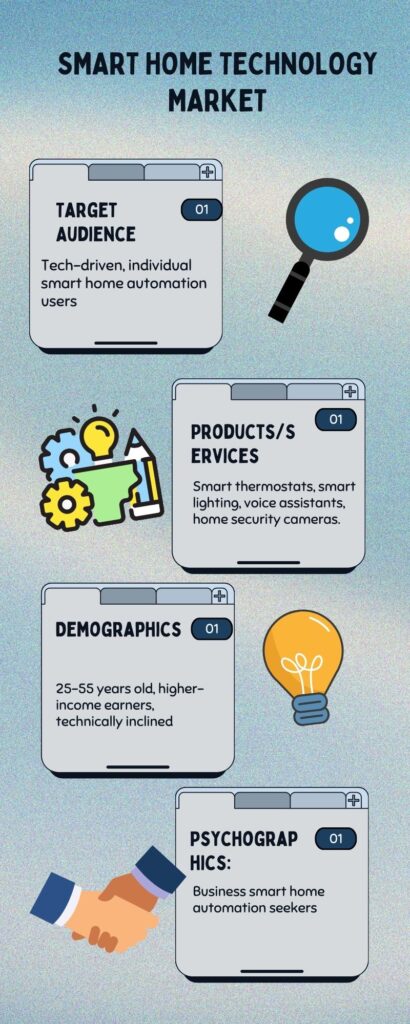
Characteristics:
- Target Audience: Tech-driven, individual smart home automation users who are looking to conveniently and securely supervise their homes.
- Products/Services: Smart thermostats, smart lighting, voice assistants, home security cameras.
- Price: Mid to high, with premiums for advanced features.
- Demographics: 25-55 years old, higher-income earners, technically inclined.
- Psychographics: Business smart home automation seekers.
- Geographics: Urban and suburban neighbourhoods in developed countries.
- Industry Focus: Consumer electronics and automation.
- Customer Loyalty: High; consumers invest in complete smart home systems.
Sub-Niches:
- Smart home energy management systems.
- Iot-enabled home healthcare devices.
Data/Statistics:
- The global smart home market is projected to grow from $79.16 billion in 2020 to $313.95 billion by 2026.
- In the United States, 45% of households had at least one smart device in 2021.
10. Sustainable Fashion Market

Characteristic:
- Target Audience: Trendy people who actively track sustainability.
- Products/Services: Sustainable clothing, upcycled garments, and rental fashion.
- Competitors: Moderate and premium brands.
- Demographics: 20 to 40 years old, living in the city, and eco-friendly.
- Psychographics: Value sustainable ethically produced fashion, and prefer quality over quantity.
- Geographies: Worldwide, particularly from sustainable cities like Stockholm, Sweden.
- Focus of the Industry: Fashion, retail.
- Customer Spend Loyalty: Moderate to high customer loyalty because of the desire to purchase sustainable goods.
Sub-Niches
- Eco-friendly activewear.
- Activewear is made from recycled materials and second-hand clothes.
Data/Statistics:
- By 2025, the sustainable fashion market will mark $9.81 billion.
- 57% of consumers are more inclined to spend on sustainable fashion brands.
What Is Broad Vs. Niche In Each Market?
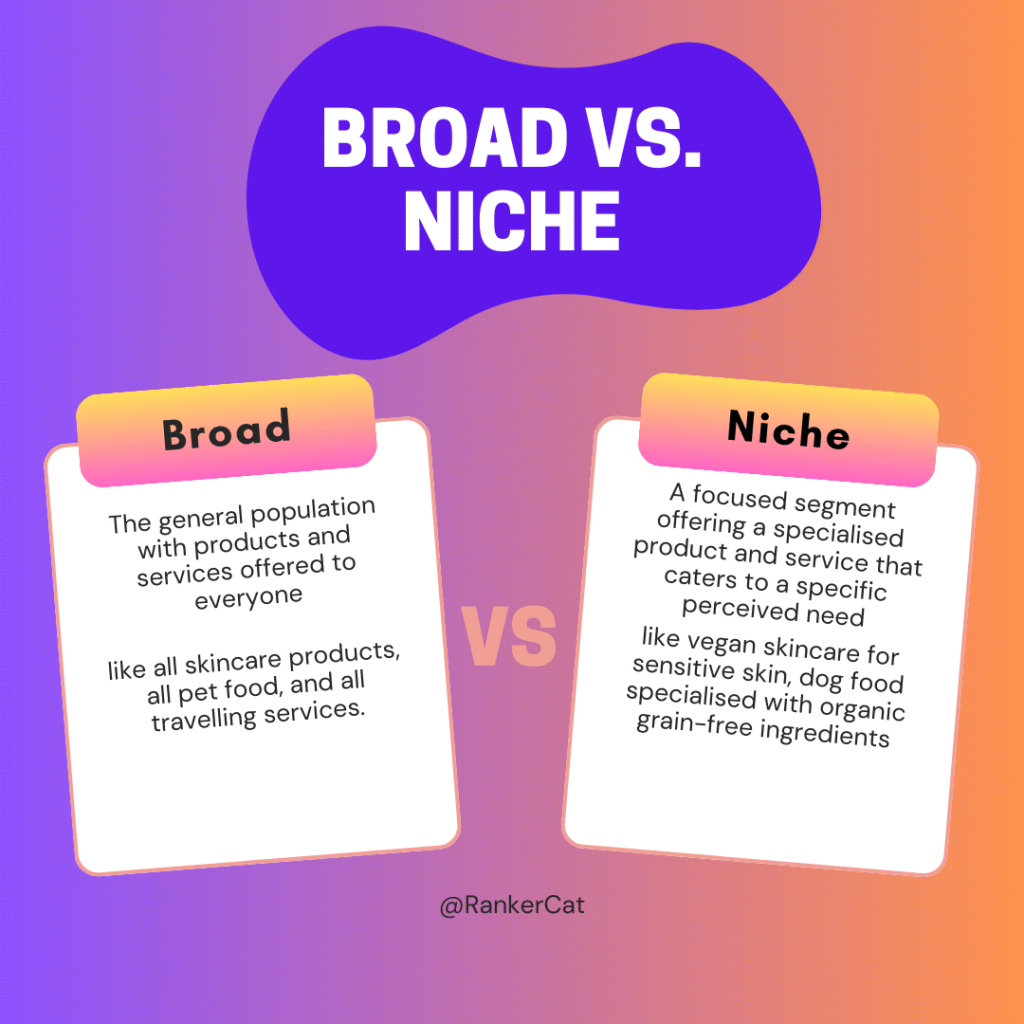
Broad Market: The general population with products and services offered to everyone, like all skincare products, all pet food, and all travelling services.
Niche Market: A focused segment offering a specialised product and service that caters to a specific perceived need, like vegan skincare for sensitive skin, dog food specialised with organic grain-free ingredients, and travel gear tailored for digital nomads.
How To Define A Niche In Each Industry
Demographics: Age, gender, income, education, such as Gen Z gamers, millennials urban pet owners.
Psychographics: Values, interests, lifestyle, such as eco-friendly shoppers, adventure travellers.
Geographics: Location, climate, urban, or rural, like city-dwellers needing rent-friendly furniture.
Product/Service Focus: A specific feature, quality, or even use case (ex., smart thermostats for energy savers).
Price Sensitivity: Focused on budget, premium, or luxury (ex., affordable fitness apps vs luxury wellness retreats).
Customer Loyalty/Potential: Level of engagement or passion (ex. Gamers, pet lovers).
Data & Statistics for Sub-Niches
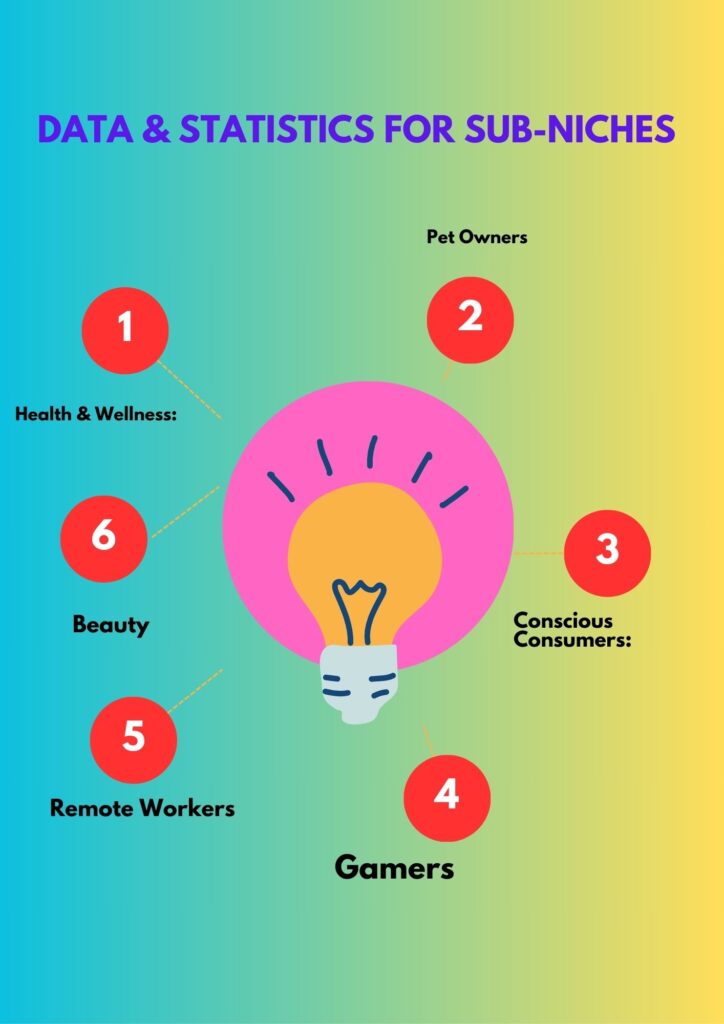
Health & Wellness: Fitness apps and wearables are growing at 15% CAGR4, placing the global wellness industry at $4.5 trillion.
Pet Owners: Projected to reach $143.6 billion by 2025, the U.S. pet industry cites organic pet food as a fast-growing sub-niche.
Conscious Consumers: As a purchase feature, sustainability ranks in at 64%, while 80% prefer to pay more for eco-conscious goods7.
Gamers: Global gamers number over 3 billion, and are projected to spend around $211 billion in 20257.
Remote Workers: 70% of professionals lean towards flexible work options, leading to a surge of products designed for home offices and virtual collaboration.
Beauty: By 2027, the global beauty market will reach $580 billion, with growing vegan and cruelty-free cosmetics.
Subscription Services: Driven by niche beauty, food, and hobby offerings, the global subscription box market will reach $1.5 trillion by 2025.
Lifestyle & Fashion: The vintage and minimalism sub-niches contribute to the budget fashion offering within the $1.1 trillion global fashion market.
Niche Product Suggestions for Popular Markets

Green kitchen products: Compostable utensils, beeswax wraps
Fitness for older adults: Low-impact workout classes and equipment.
Adventure pet gear: Dog GPS collars and backpacks.
Gamer gear: Ergonomic chairs, bespoke gaming keycaps.
Home automation: Smart locks, voice-controlled lights.
Remote working kits: Portable standing desks, webcam lighting.
Veggie makeup: Plant-derived serums and cruelty-free makeup.
Travel gear: Packable jackets and RFID wallets.
Subscription boxes: Themed snack boxes and monthly books.
Online courses: Coding classes for children and mobile applications for teaching languages.
Finding and validating a niche
- Analyse social media and survey data to evaluate demographics and psychographics.
- Examine industry reports for emerging sub-niche trends and growth potential.
- Evaluate competition to identify gaps where service is lacking.
Implement demand solver products or market test offerings to evaluate the need and adjust the final product.
Summary Table: Broad vs. Niche Example
| Industry | Broad Market Example | Niche Market Example |
| Beauty | All skincare | Vegan, fragrance-free serums |
| Fitness | General gym memberships | HIIT for busy professionals |
| Food | Mass-market snacks | Keto-friendly, gluten-free bars |
| Pet Care | Standard pet food | Organic, breed-specific dog food |
| Travel | All-inclusive resorts | Digital nomad co-living spaces |
| Tech | General electronics | Wearable e-readers for book lovers |
Defining a niche means starting with a larger market and refining it down to a specific segment that is passionate about and has needs that are not catered to within that market. This allows businesses to create tailored products around the specific needs of a community, charge them premium prices, and accrue loyal customers, but it also requires a considerable amount of segmentation knowledge and an understanding of trends and customer behaviour. The most successful niche businesses are the ones that continually develop and adjust as new sub-niches form and change.
How to Find a Niche in Any Business: 10 Proven Steps, Tools, Strategies, and Examples
Finding a profitable niche can be both a goal and a challenge for already established businesses or new entrants. With narrower competition, a niche target market allows easier targeting, proving to be extremely useful for building brand loyalty. In the lines below, you can find the specific niche tailored to your business with the help of a comprehensive data-driven guide, which includes actionable steps, expert quotes, and brand examples.
10 Steps to Find a Niche in Any Business
| Step | Action | Details & Tools | Example/Expert Insight |
| 1 | Self-Assessment | List your passions, skills, and experience. | Oleksiy Torokhtiy: “Let your niche find you—start with what you love and are good at.”13413 |
| 2 | Brainstorm Potential Niches | Combine your interests with market needs. Use Google, niche forums, and Amazon subcategories. | Paul Chow: Passion for 3D printing led to a custom solutions business.1716 |
| 3 | Market Research | Analyse demand using Google Trends, SEMrush, and industry reports. | Shopify: Use Google Trends to check if “vegan shoes” is growing or declining.31320 |
| 4 | Identify Gaps & Problems | Read reviews, join communities (Reddit, Facebook groups), and look for pain points. | Frostbeard Studio: Noticed a lack of book-themed candles for readers.1718 |
| 5 | Evaluate Competition | Use tools like CompetitorLens and NicheFinder 360 to assess market saturation and competitor weaknesses. | Bonobos: Saw poor fit in men’s pants and filled the gap online.152 |
| 6 | Define Your Unique Value Proposition | Clarify what sets you apart—quality, price, service, or innovation. | Nike: Started with running shoes for athletes, focused on quality and innovation.8 |
| 7 | Validate Market Size & Profitability | Check Total Addressable Market (TAM), target market size, and growth rate. | Use Google Keyword Planner and Statista for data; niche sites have 29% higher conversion rates.310 |
| 8 | Test & Get Feedback | Launch a minimum viable product (MVP), run ads, or pilot services. Use SurveyMonkey or Typeform for feedback. | Jason Bland: Built around most successful clients and refined offerings.1513 |
| 9 | Refine & Narrow Down | Segment further by demographics, psychographics, or geography. | Nomatic: Focused on digital nomads needing travel gear.617 |
| 10 | Monitor Trends & Adapt | Use TrendCatcher and MarketScout to spot emerging trends and pivot as needed. | Tesla: Started with luxury EVs, expanded as tech and demand evolved.92 |
Tools and Tactics for Niche Discovery
Insight, NicheFinder, MarketScout: Analytics tools that provide real-time insights on market activity and competition.
- SubNicheXpert: A tool specifically designed to turn large markets into profitable sub-niches.
- CompetitorLens: A tool designed for tracking and measuring competition.
- AudienceMap: Provides in-depth demographic and psychographic data on a specific audience.
- Google Trends, SEMrush, and Statista measure market size and check trends.
- Social Media & Forums: Reddit and Facebook groups, along with some other forums, provide useful community information
- Online Surveys: Through SurveyMonkey and Typeform to get information directly from clients.
- Amazon & Flippa: Check out subcategories like proven niche ideas or browse through business directories.
Brand Examples & Expert Opinions
- Nike: After innovating, it started with track athlete-specific running shoes. They expanded later to wider mass-marketed sportswear.
- Tesla: Focused on early adopters with the Roadster (luxury electric sports car), and later shifted to mass market EVS and home energy solutions.
- Frostbeard Studio: Validation through Etsy: Started as a book-themed candle maker, snowballed to selling in bookstores nationwide.
- Bonobos: Noticed a gap in the fit of men’s pants, built a brand centred around perfect-fitting pants and scaled rapidly.
- Nomatic: Designed travel luggage for digital nomads targeting remote workers and travellers.
- Instructions: Niche Finding for Current vs. Upcoming Businesses For Currently Operating Companies
- Examine Your Clients: Look into the profile of your customers and focus your marketing activities on the most profitable groups.
- Check Sales Report: Analyse your past sales to determine the most popular and profitable products.
- Use Feedback Processes: Make changes to your niche, capitalise on customer feedback, and actively use testimonials.
- Expand Within Your Niche: Add or create new products and services in adjacent smaller niches related to what you already offer.
For New Business Developers
- Go With Passion First: Always start where you enjoy and have adequate knowledge or background.
- Put in Effort in Detailed Market Strategy: Validate your competition and demand using niche research tools.
- Do Not Scale Too Quickly: Make efforts to try out ideas with a small group first and adapt based on what they say.
- Be Flexible: Always be ready to change your plans as you learn about your audience and changing market conditions.
- Facts & Figures: Reasons Focused Niche Works
There’s a 45% increase in the conversion rate for targeted affiliate resources on niche websites.
75% of specialised marketplace websites rank among the top 10 Google query results for their main keywords.
Dedicated e-commerce niche sites outperform broad e-commerce by 29% in conversion rates.
72% of successful bloggers base their success on adopting a focused niche10.
The global market of subscription-based services (a focused niche approach) will be $1.5 trillion by 2025.
Chart: The Niche-Finding Process
text
| Step | Key Activity | Tool/Resource Example |
|—————————-|——————————-|———————————–|
| Self-Assessment | List passions/skills | Personal reflection, Ikigai |
| Brainstorm Niches | Combine interests/needs | Google, Amazon subcategories |
| Market Research | Analyze demand/trends | Google Trends, Statista |
| Identify Gaps | Read reviews, join forums | Reddit, Facebook Groups |
| Evaluate Competition | Assess saturation | CompetitorLens, NicheFinder 360 |
| Define USP | Clarify differentiation | SWOT Analysis |
| Validate Market | Check size/profitability | Keyword Planner, SEMrush |
| Test & Feedback | MVP, pilot, surveys | SurveyMonkey, Typeform |
| Refine & Narrow | Segment by audience | AudienceMap, SubNicheXpert |
| Monitor & Adapt | Spot trends, pivot | TrendCatcher, MarketScout |
The ideal niche is formed where your passion, expertise, and a real market gap coexist. Refinement should be made through community feedback-driven data insight tools and market analysis. For both budding and established businesses, what matters is unwavering attentiveness towards a target audience while remaining adaptable to changes, like leading brands such as Nike, Bonobos, or Tesla.
Remember
Niche markets are not merely about being small; they are about being hand-tailored, influential, and essential to a certain categorisation of clientele.
10 Hyper-Specific Marketing Ideas for 2025, Innovations and Growth Hacks
It’s all about granular audiences, scanning new trends, and differentiating hyper marketing tactics to create a niche in 2025. Here are 10 untapped niches with distinctive marketing strategies and growth hacking techniques designed to increase engagement and conversions.
1. Sustainability In Mind
Differentiation: Each category of eco-friendly consumers is paying attention to its sector, with 64% of buyers willing to pay more for greener options.
Marketing Strategy:
- Certification Marketing: Promotes B Corp or Fair-Trade certifications to boost sales. Obtainable Trust.
- Community Challenges: Collaborate with micro influencers for “30 Day Zero Waste” challenges.
Growth Hacking:
- Referral Discounts: 15% discount for sharing sustainable tips on Instagram.
- Explain how using assistive bots on carbon footprint explaining saves to check out.
2. Indie developers: Gamer Stereotype
Differentiation: Value gamers from all over the world (3B), including sub-niches as retro or eSports.
Marketing strategy:
- Sponsorship of streamer unboxings on Twitch challenges gamers to share their purchase of new peripherals.
- VGC is integrated within the gam, and proceeds with GP share as in-game cashback programs.
Growth Hacking:
- VGC pays for the GP promo. Assign points.
3. Enthusiasts of Technology
Differentiation: Expect spending on gadgets and gear to peg at 5.74 trillion globally. Early adopters are already hungry for new gadgets.
Marketing Strategy:
- Beta Testing Communities: Gather feedback for offering pre-launch access such as Sol Reader’s wearable e-reader6.
- YouTube Tutorials: Provide tutorials for niche use cases such as Raspberry Pi hacks for smart homes.
Growth Hacking:
- Reddit AMAS: Post promotional Q&A sessions in r/gadgets for credibility.
- Affiliate Programs: Commission-based reviews from micro-influencers on social media.
4. Digital Nomads
Differentiation: Markets to more than 11 million remote workers seeking portable gear and tools6.
Marketing Strategy:
- Co-Living Partnerships: Include products in memberships like Nomatic backpacks bundled with Selina Co-Living memberships.
- Productivity Challenges: Run promotional “Remote Work Hack” campaigns with free toolkit giveaways.
Growth Hacking:
- Freemium Models: Propose free trials for AI-powered scheduling assistants.
- LinkedIn Carousel Ads: Nomadic CEOS endorse their peers’ businesses. Share CEO testimonials.
5. Health & Wellness
Differentiation: Targets the fitness and mental well-being segments of consumers, spending $4.2 trillion1.
Marketing Strategy:
- App Personalisation: Implement AI technologies to personalise workout or meditation sessions to users.
- Wellness Retreats: Yogatherapy promotion in Bali yoga retreats for influencers.
Growth Hacking:
- UGC Campaigns: Encourage users to get social media posts to share their fitness journeys by tagging the campaign for discounts.#MyFitnessJourney
- Subscription Boxes: Curated vitamin packs with personalised notes sent monthly.
6. Pet Tech
Differentiation: Focus on innovation targeting pet owners who are estimated to spend $103 billion annually.
Marketing Strategy:
- Smart Product Demos: TikTok videos demonstrating GPS trackers showcase their benefits.
- Vet Partnerships: Joint promotional campaigns of organic pet food with vet clinics.
Growth Hacking:
- Pet-Themed Photography Contests: Encourage user participation by providing free item samples.
- Monthly Food Subscription discounts: Cuts prices by 20 per cent on pet food for scheduled deliveries.
7. This includes innovative designs or clothing made with previously used materials, referred to as sustainable fashion.
- Marketing Strategy: Advertise for renting clothes for special occasions using Instagram Stories.
- Upcycled Collaborations: Collaborate with artists to redesign discarded materials into wearable art.
Growth Hacking:
- Virtual Try-Ons: Use AR filters for “outfit tests” on Instagram.
- Limited releases: Upcycled collections are sold in small quantities as a marketing tactic to create high demand.
8. Integrative Family Telehealth
Differentiation: Focuses on active lifestyle consumers(split of thrill-seekers and casual users, 15% compound annual growth rate expected).
Marketing Strategy:
- Interactive Content: “Choose Your Adventure” quizzes to recommend gear collection can be designed.
- Eco-Tourism Packages: Work with NGOS to provide carbon offset safaris.
Growth Hacking:
- Referral Rewards: Free travel guides are provided for every friend booked.
- Geo-targeted Advertisements: Offer hikers in national parks backpack ads.
9. Smart Home Tech Family Pack
- Differentiation: Focussplit of forest and trekking enthusiasts(marked for $313 billion in 2026)
- Marketing strategy: Demo videos: Show lighting turning on and off via voice control in real homes.
- Energy savings estimates: Summarise the marketing Growth Hacking:
- Offer discounts on buying smart locks alongside security cameras.
- Early bird: Give exclusive early access to pre-orders for new Internet of Things devices.
10. Family Pack of Local Artisans.
It’s aimed at serving local communities that value the goods artisans make by hand. Don’t forget, 75% of people born between 1980-1995 still prefer vintage items.
- Marketing Strategy: Pop-Up Shops: Organise local craft shows with in-person crafting sessions.
- Content with a Narrative Arc: Place artisan biographies on YouTube.
- Growth Hacking:
- SEO at a Granular Level: Geotag optimisation for “pottery created by hand close to my current location” works.
- Collaborative Kits: Market candle-making kits along with locally sourced materials.
Common Marketing Practices Across Niches
- Hyper-Personalisation: Use tools like AudienceMap to segment by behaviour (e.g., eco-conscious vs. budget shoppers).
- Micro-Influencers: Partner with niche experts (63% higher conversions than celebrities).
- Community Building: Create branded forums or Slack groups for loyal customers.
Growth Hacking Tactics for Niche Products
| Tactic | Example | Outcome |
| Viral Referrals | Dropbox’s free storage for shares | 60% signup growth |
| Co-Marketing | Taco Bell × Doritos collab | 15K hires to meet demand |
| Gamification | Duolingo’s streak rewards | 3x app retention |
| AI Chatbots | Personalised upsell prompts | 25% revenue boost |
Key Takeaway
Niche success in 2025 hinges on precision and agility. Brands must blend data-driven personalisation, community engagement, and experimental growth tactics to dominate their segments. Whether targeting eco-conscious shoppers or tech enthusiasts, the winners will be those that innovate while staying true to their audience’s core values.
FAQ: Searching for a Niche in a Business (2025 Edition)
Guide entrepreneurs and business owners through discovering and flourishing in a niche market. Formulated off common questions from Google and Answer the Public, as well as the latest industry insights, this document serves as a detailed and one-of-a-kind guide.
What is a niche in business, and what does it signify in 2025?
A niche in business is a distinct segment within the larger market. It is characterised by particular demands, needs, and wants that other mainstream competitors focus on. It’s more important than ever to use strategic and sustainable calculations to locate niches because globally, 66% of consumers report being willing to spend more on specialised or sustainable brands.
How do I identify a profitable niche market?
Begin by analysing what you love doing: Businesses stemming from a founder’s passion or expertise tend to hit the market better. Take, for example, Bee’s Wrap eco-friendly wraps.
Conduct thorough research: With Google Trends, SEMrush, and other industry reports, you can find areas with rising demand, such as the booming $4.2T health and wellness market, as well as adventure tourism, which boasts a 15% CAGR.
Search to find solutions: Customers frequently express their wishes or complaints through reviews they post on forums. Partake in these actively to gain invaluable insights.
Validate with numbers: Analyse if there is enough demand in your niche and if customers are willing to pay a premium price for it. For example, 80% of shoppers will pay more for eco-friendly goods.
How narrow should my niche be?
A good niche should minimise competition, but not be too specific, allowing for growth. Instead of “pet products,” you can target “organic dog food for small breeds.” While the total pet industry in the US was 103.6 billion in 2020, organic pet food is its fastest-growing sub-niche.
Is it possible for me to change my niche later?
Yes, many brands start with a narrow niche and expand from there. Take Nomatic as an example. They started with travel backpacks for digital nomads, but now have a full range of travel gear. Continuously doing market research, along with having flexibility, is essential.
What tools and strategies can I use to find a niche in 2025?
SE SEO Tools: SEMrush, Google Keyword Planner, and Ahrefs for tools related to search demand.
Social Listening: Keep an eye on conversations taking place on Facebook Groups, Reddit, and other niche forums. Look for emerging conversations.
Competitors: Tools like SimilarWeb or NicheFinder help fill the gaps.
Surveys and feedback: Get direct responses from potential customers using Typeform and SurveyMonkey.
Print on Demand Platforms: Use Gelato and Printify for testing niche products with low risk.
What will be some niche markets in demand in 2025 and beyond?
Sustainable Products: Eco-Friendly Products have a (CAGR of 9.1% through 2028)13.
Health and Wellness: Fitness gadgets, mental wellness applications, and ergonomic home office furniture.
Gamers: Specialised gaming hardware, e-sports merchandise (3B gamers globally)36.
Digital Nomads: Tools for remote work, co-living spaces (Digital Nomads: 11 M+, annual growth 17%)1.
Sustainable Fashion: Upcycled and rental clothing (Value to reach $9.81B by 2025)1.
How do I know if a niche is worth pursuing?
- Market Size: Check the TAM (Total Addressable Market) using Statista or any other industry report.
- Growth Rate: Seek out markets that have a double-digit CAGR.
- Customer Satisfaction: 59% of Americans are likely to spend on mental wellness products1.
- Pilot Testing: Provide a VMP and test the waters first.
- What are the risks associated with niching down too far?
- Market may be too narrow: The number of customers is insufficient to turn a profit.
- Trends shift: Case in point, the rise and fall of fidget spinners.
- Saturation: Run-of-the-mill niches draw in competitors at an alarming rate.
- Over-specialisation: Reduces the ability to diversify when the market shifts.
How do I market a niche business differently?
- Hyper-personalisation: Edit messaging to address specific values (eco-shoppers example: savings on carbon footprint).
- Niche Creation: Start a forum, Slack group, or loyalty program for your niche.
- Micro-influencers have a 63% better sales conversion rate compared to celebrity endorsements3.
Referral marketing, user-generated content, gamification, and even self-gamifying actions, like in the cases of Dropbox’s viral referral program and Duolingo’s streak rewards, are examples of growth hacking2.
Is it possible for an already existing company to discover a new niche?
Absolutely. Examine your most valued customers, analyse sales data for profit margin products, and utilise feedback. For instance, a pet store could capitalise on the growing demand for pet GPS trackers by diversifying into high-tech pet wearables.
Share some successful niche brands.
- Bee’s Wrap – Eco-friendly food wraps targeted towards consumers who care for the environment.
- Nomatic – Travel accessories for digital nomads3.
- Frostbeard Studio – Book-themed candles designed for readers.
- BioLite – Solar-powered equipment for outdoor enthusiasts.
- The Blissful Mind – Self-care resources for professionals.
How will niches evolve in the future?
Niche markets will most likely outpace the growth of mass markets due to increasing demand for personalisation, sustainability, and distinctive experiences. By 2028, segments like eco-friendly products, digital wellness, and remote work aides will rapidly expand.
- Summary Table: Niche Discovery Essentials
- Step Tool/Resource Key Metric/Example
- Market Research: Google Trends, SEMrush Search volume, trend graphs
- Community Insights Reddit, Facebook Group, Unmet needs, pain points
- Validation Surveys, MVP launch, Conversion rates, feedback
- Growth Hacking Referral programs, UGC Viral signups, engagement metrics
About 2025, uncovering a niche requires an integration of insightful research, community interaction, and flexibility. Businesses that are most likely to succeed are the ones that pay the closest attention to their customers and capitalise on emerging trends as they arise.


Leave a Reply